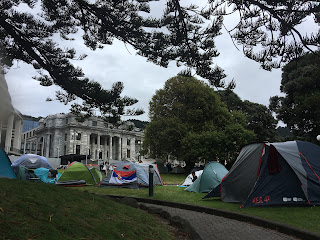Quite early this morning I went down to parliament to look for myself and get a feel for the mood.
Yesterday the police spent hours pushing back the crowd mere metres only to re-lose the ground and enflame the situation with 122 arrests achieved by picking off protestors one-by-one. This morning all that battleground has been covered with marquees and across the complex, more tents have gone up. I imagine by the weekend there will be no visible lawn left.
All of the roads immediate to parliament and alongside the National Library have parked lanes of vehicles, utes, campervans, buses, rigs and a couple of food trucks. Either they all leave in unison or nobody goes - anywhere.
And I don't think they are going anywhere any time soon. It's an occupation. And it seems totally fitting to me that the citizens occupy the land surrounding the workplace of their representatives.
The mood is pleasant, chatty, convivial BUT after yesterday there is much more preparedness for further action from the police.
I left feeling sure the police won't move today. A repeat of yesterday would be utterly futile. Worse, it would attract even more people who are first and foremost looking for trouble, which those protesting the vaccine mandates aren't. They are looking for a change of heart from government.
That would be the simplest solution to this unprecedented show of resistance which will only get stronger in the coming days. Any other 'resolution' doesn't bear thinking about.
Update: They were not in view this morning but now at least two very large banners are saying "End Mandates, We Go Home." It couldn't be clearer.







